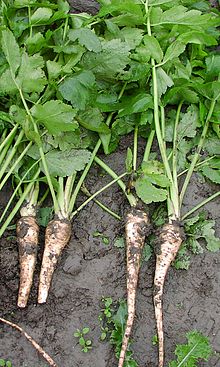Parsnip
| Parsnip | |
|---|---|
 |
|
| Scientific classification | |
| Kingdom: | Plantae |
| (unranked): | Angiosperms |
| (unranked): | Eudicots |
| (unranked): | Asterids |
| Order: | Apiales |
| Family: | Apiaceae |
| Genus: | Pastinaca |
| Species: | P. sativa |
| Binomial name | |
|
Pastinaca sativa L. |
|
| Nutritional value per 100 g (3.5 oz) | |
|---|---|
| Energy | 314 kJ (75 kcal) |
|
18 g
|
|
| Sugars | 4.8 |
| Dietary fiber | 4.9 g |
|
0.2 g
|
|
|
1.2 g
|
|
| Vitamins | |
| Thiamine (B1) |
(8%)
0.09 mg |
| Riboflavin (B2) |
(4%)
0.05 mg |
| Niacin (B3) |
(5%)
0.7 mg |
| Pantothenic acid (B5) |
(12%)
0.6 mg |
| Vitamin B6 |
(7%)
0.09 mg |
| Folate (B9) |
(17%)
67 μg |
| Vitamin C |
(20%)
17 mg |
| Vitamin E |
(10%)
1.49 mg |
| Vitamin K |
(21%)
22.5 μg |
| Minerals | |
| Calcium |
(4%)
36 mg |
| Iron |
(5%)
0.59 mg |
| Magnesium |
(8%)
29 mg |
| Manganese |
(27%)
0.56 mg |
| Phosphorus |
(10%)
71 mg |
| Potassium |
(8%)
375 mg |
| Sodium |
(1%)
10 mg |
| Zinc |
(6%)
0.59 mg |
| Other constituents | |
| Water | 79.53 g |
|
|
|
|
|
| Percentages are roughly approximated using US recommendations for adults. Source: USDA Nutrient Database |
|
The parsnip (Pastinaca sativa) is a root vegetable closely related to the carrot and parsley. It is a biennial plant usually grown as an annual. Its long, tuberous root has cream-colored skin and flesh; and left in the ground to mature, it becomes sweeter in flavor after winter frosts. In its first growing season, the plant has a rosette of pinnate, mid-green leaves. If unharvested, it produces its flowering stem, topped by an umbel of small yellow flowers, in its second growing season. By this time, the stem is woody and the tuber is inedible. The seeds are pale brown, flat, and winged.
The parsnip is native to Eurasia. It has been used as a vegetable since antiquity and was cultivated by the Romans, although some confusion exists in the literature of the time between parsnips and carrots. It was used as a sweetener before the arrival in Europe of cane sugar. It was introduced into the United States in the 19th century.
The parsnip is usually cooked, but can also be eaten raw. It is high in vitamins and minerals, especially potassium. It also contains antioxidants and both soluble and insoluble dietary fiber. It can be cultivated in deep, stone-free soils. It is attacked by the carrot fly and other insect pests, viruses, and fungal diseases, of which canker is the most serious. Handling the stems and foliage can cause a skin rash if the skin is exposed to sunlight after handling.
The parsnip is a biennial plant with a rosette of roughly hairy leaves that has a pungent odor when crushed. Parsnips are grown for their fleshy, edible, cream-colored taproots. The roots are generally smooth, although lateral roots sometimes form. Most are cylindrical, but some cultivars have a more bulbous shape, which generally tends to be favored by food processors as it is more resistant to breakage. The plant's apical meristem produces a rosette of pinnate leaves, each with several pairs of leaflets with toothed margins. The lower leaves have short stems, the upper ones are stemless, and the terminal leaves have three lobes. The leaves are once- or twice-pinnate with broad, ovate, sometimes lobed leaflets with toothed margins; they grow up to 40 cm (16 in) long. The petioles are grooved and have sheathed bases. The floral stem develops in the second year and can grow to more than 150 cm (60 in) tall. It is hairy, grooved, hollow (except at the nodes), and sparsely branched. It has a few stalkless, single-lobed leaves measuring 5 to 10 cm (2 to 4 in) long that are arranged in opposite pairs.
...
Wikipedia
